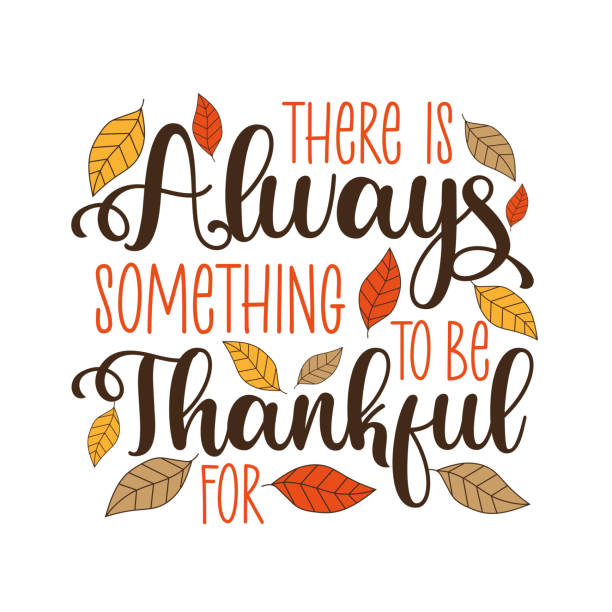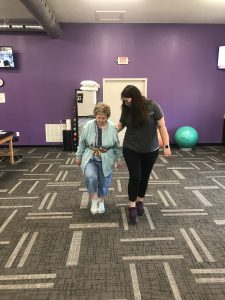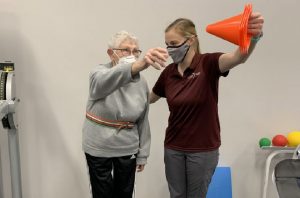Total Knee Rehab
December 6, 2022
Total knee arthroplasties, also known as knee replacements, have become quite popular throughout the country and the world. Within the United States alone, upwards of 600,000 knee replacements are completed each year. It has become one of those routine procedures used to decrease pain, improve mobility, and help citizens return to their prior level of function. The average age of a total knee recipient has lowered over the years to 66, whereas 70-80 used to be the baseline.
There are many reasons one may need to consider a total knee replacement. Wear-and-tear is one of them. Throughout the years, our knees carry a heavy load with all of the walking, running, jumping, and squatting activities we complete during our life. All of this heavy-duty activity can cause a natural breakdown of the tissues and cartilage within the knee joint. A breakdown of soft tissue will create excess pain and dysfunction, making these types of activities difficult. Arthritis is one of the top causes of total knee replacements. Arthritis is swelling, pain, and often times crepitus, or “crackling”, within the joint. Overtime, arthritis can advance far enough along to limit your ability to move freely, creating pain with simple tasks such as stair climbing, getting in and out of the car, or standing up from the commode. Replacing the joint helps clear out the arthritis and improve your function as well as give you your independence back when it comes to those simple daily tasks. Prior injury can also be reason for needing a replacement. Damage to the soft tissue has a tendency to create pain and loss of function over time.
The procedure itself consists of the clearing and removal of damaged bone and tissue, then replacing it with hardware to create a “new” knee joint that functions very similarly to the old. Restrictions following surgery will be minimal-none, so it is likely your doctor will want you to start therapy within a few days. Therapy will be focused on range of motion, strength, and weight bearing tolerance from day one. Most will come out of surgery and be required to use a walker in order to assist in getting around. As the muscles get stronger, a transition from walker to cane, then cane to fully independent walking will occur. Goals will vary with each individual patient, but ultimately your therapists aim at getting your function back to where you were before your knee pain began.
Therapy can be a little overwhelming in the beginning. Post-surgical swelling, pain, and tightness will cause a difficulty in obtaining your prior level of function. The first couple weeks are generally geared towards gaining motion (getting your full bend and straighten out of the new knee). Many will describe the knee flexion range of motion, or bending, as feeling as though the hardware is going to “pop out of the skin”. This is simply the increased tension within the muscle tendons around the hardware as it all heals. Therapists may apply some soft tissue work, or massage, to the knee joint in order to decrease this tension and make the range of motion a little more tolerable. Obtaining full extension, or knee straightening, is just as important as the knee flexion. There are many different ways to improve knee extension after surgery. Simply propping your heel up on a towel roll with a small amount of weight at the thigh is a great exercise to improve the extension and thus, improve the gait pattern.

Early strengthening begins with isometrics. Isometrics are strengthening exercises that can be completed with the legs without actually moving the joints, making it a little more tolerable. Quad function is pertinent to proper recovery of the knee. The quad is the thigh muscle just above the knee cap. It is in charge of straightening the knee which is needed for a proper gait pattern. We never want to forget about the hip and ankle muscles after a total knee replacement. Strengthening muscles above and below the replaced joint will give a more, well-rounded approach to recovery and allow the entire limb to function as one unit again. Once control of the muscles in the leg has been obtained, you will then move into active and resisted range of motion. This includes any exercises where you are moving the leg on your own, without any assistance. This could include exercises with bands or weights to improve that strength. Progressions through active/resisted range of motion will eventually get you back to recreational activities you once enjoyed.
Weight bearing tolerance must be addressed from the get-go in order to obtain that normal walking pattern again. We begin with gentle exercises such as weight shifts to introduce the leg to the feel of the new knee. We then move into more challenging exercises such as small step ups, single leg balancing activities, squats, or sit to stand transfers. All of these exercises help place your body weight through your leg and ultimately strengthen the muscles to improve your tolerance to daily activities.
While total knee arthroplasties are more commonplace today than they had been in the past, it can still be a process to recover from. Therapy is an important stage in that recovery process and should be completed by each patient choosing to undergo this surgery. Your therapists will work with you to create a regimen that best suits your needs so you can feel as comfortable as possible with the progressions. Completing a therapy regimen following a knee replacement will allow you to return to your prior level of function and daily activities without the dysfunction of the knee joint. If you are considering a knee replacement and aren’t sure whether it is something that is best for you, discuss your options with your doctor and therapist. They will be able to give you the best advice for your given situation.











